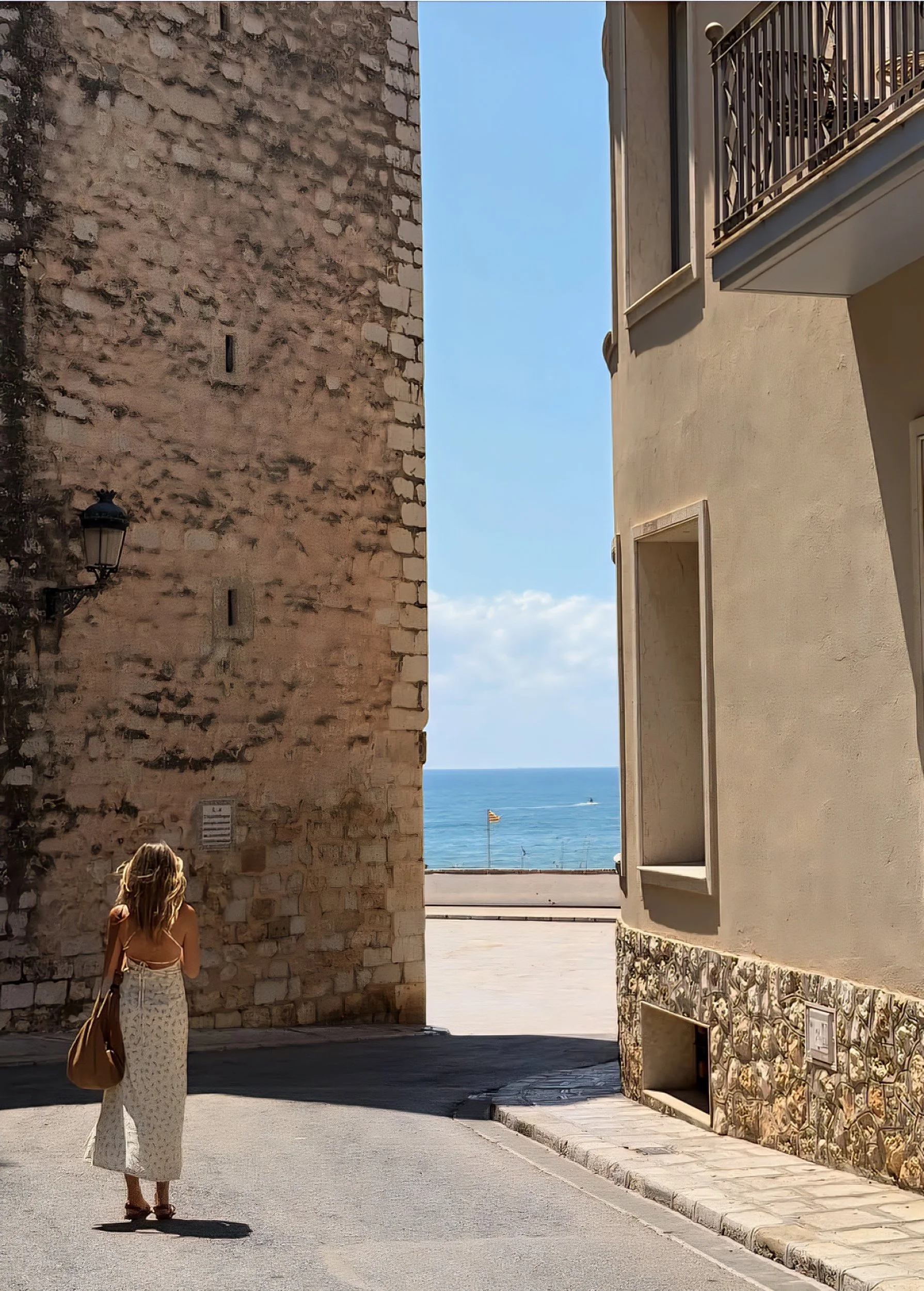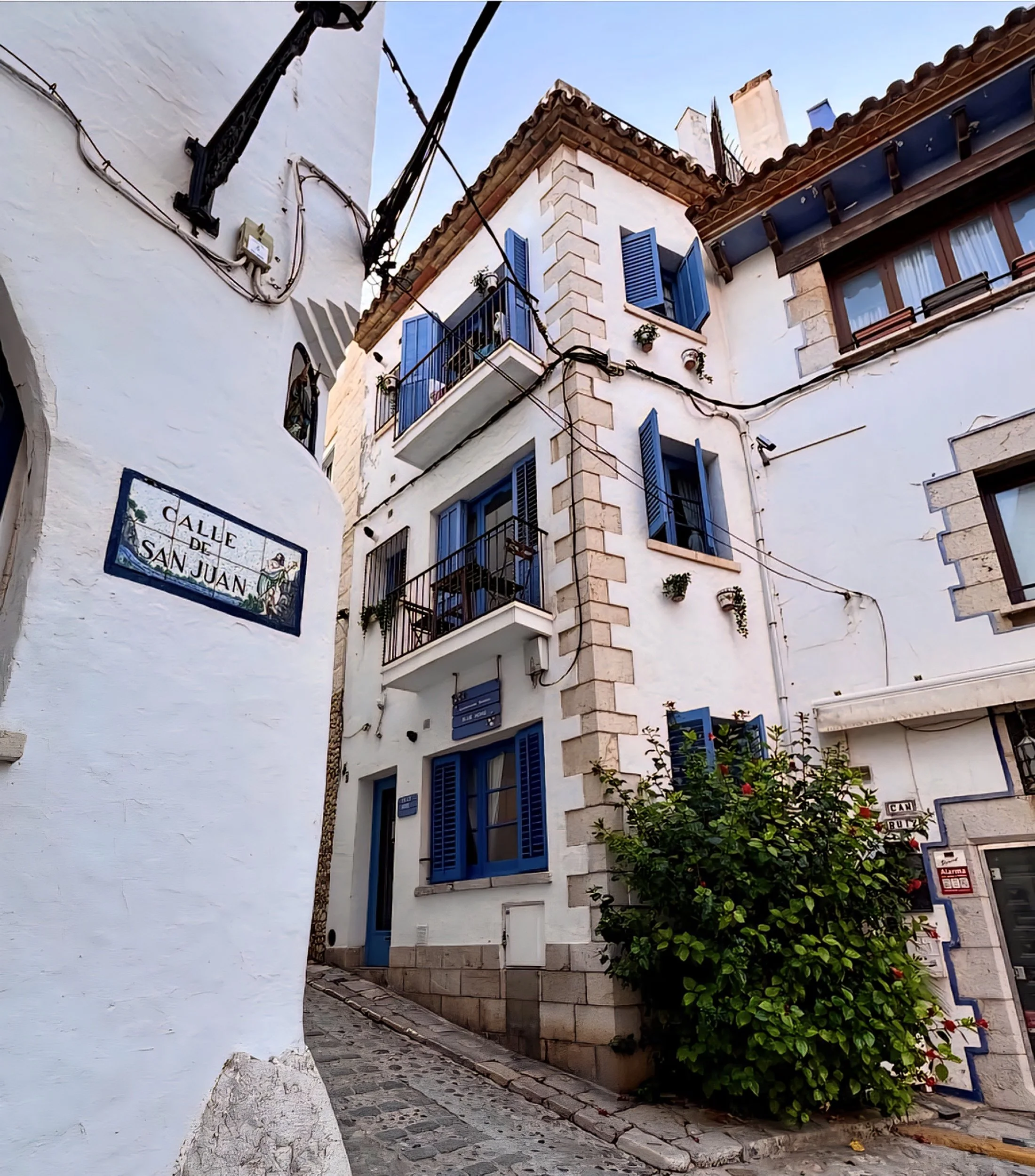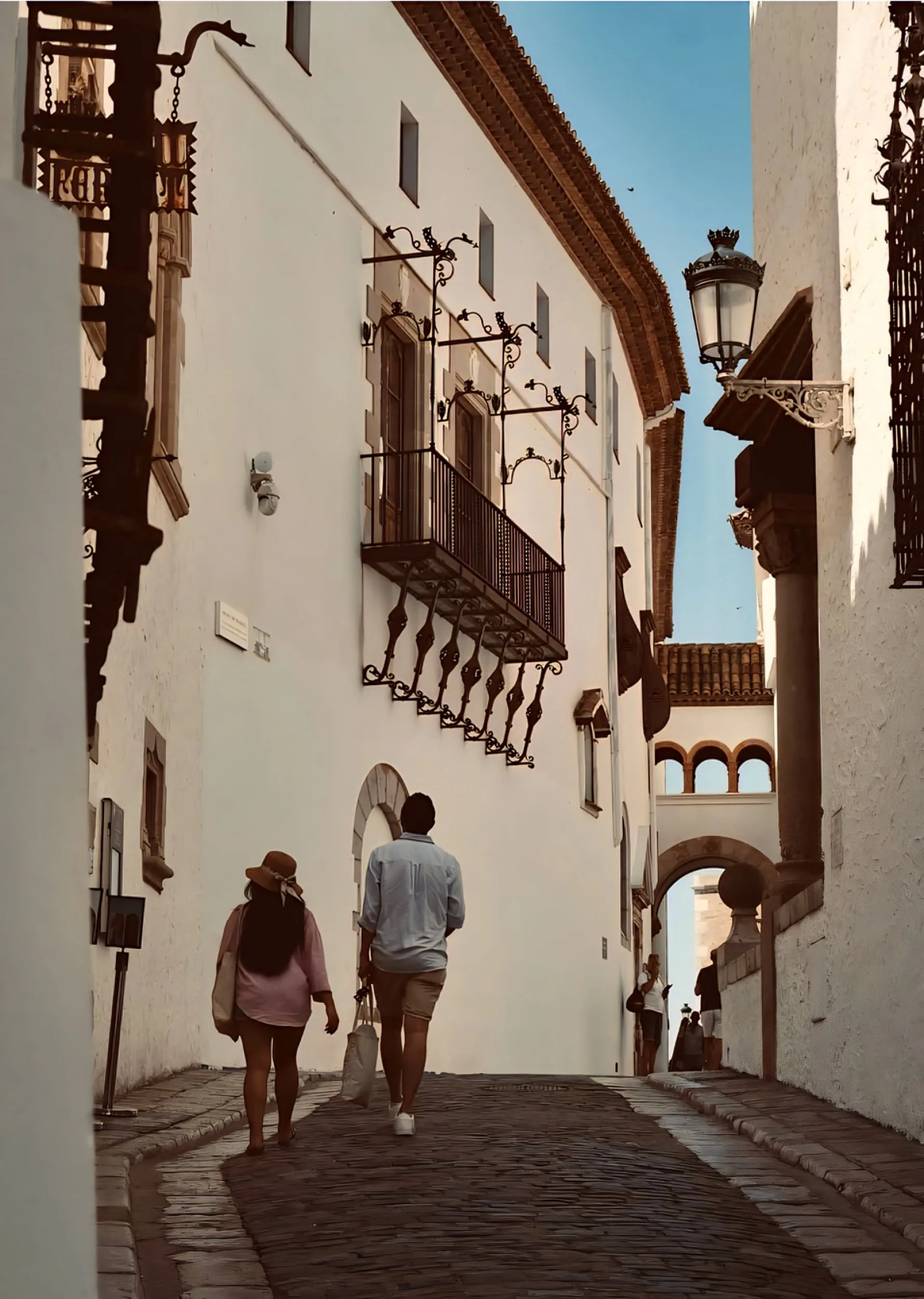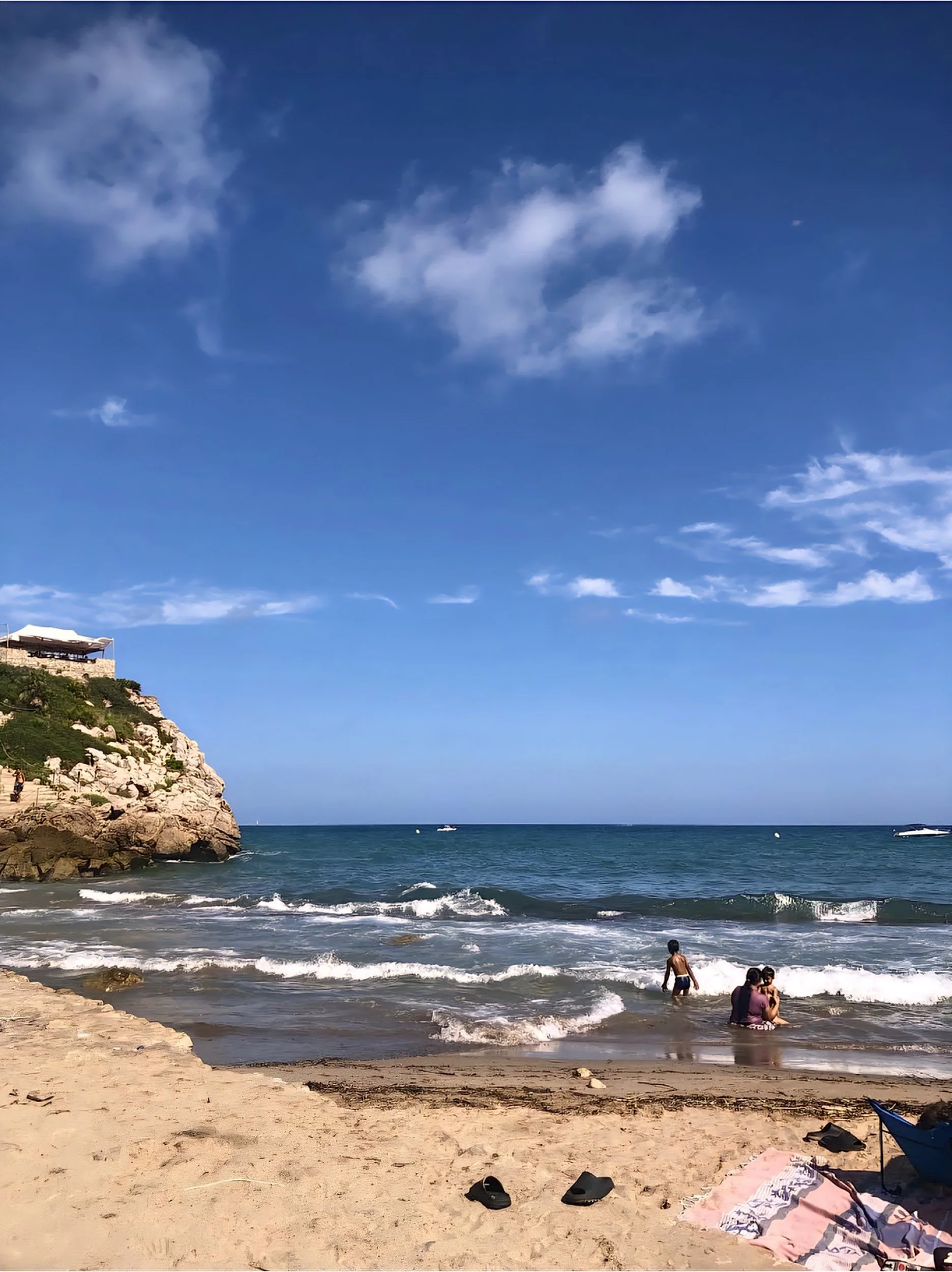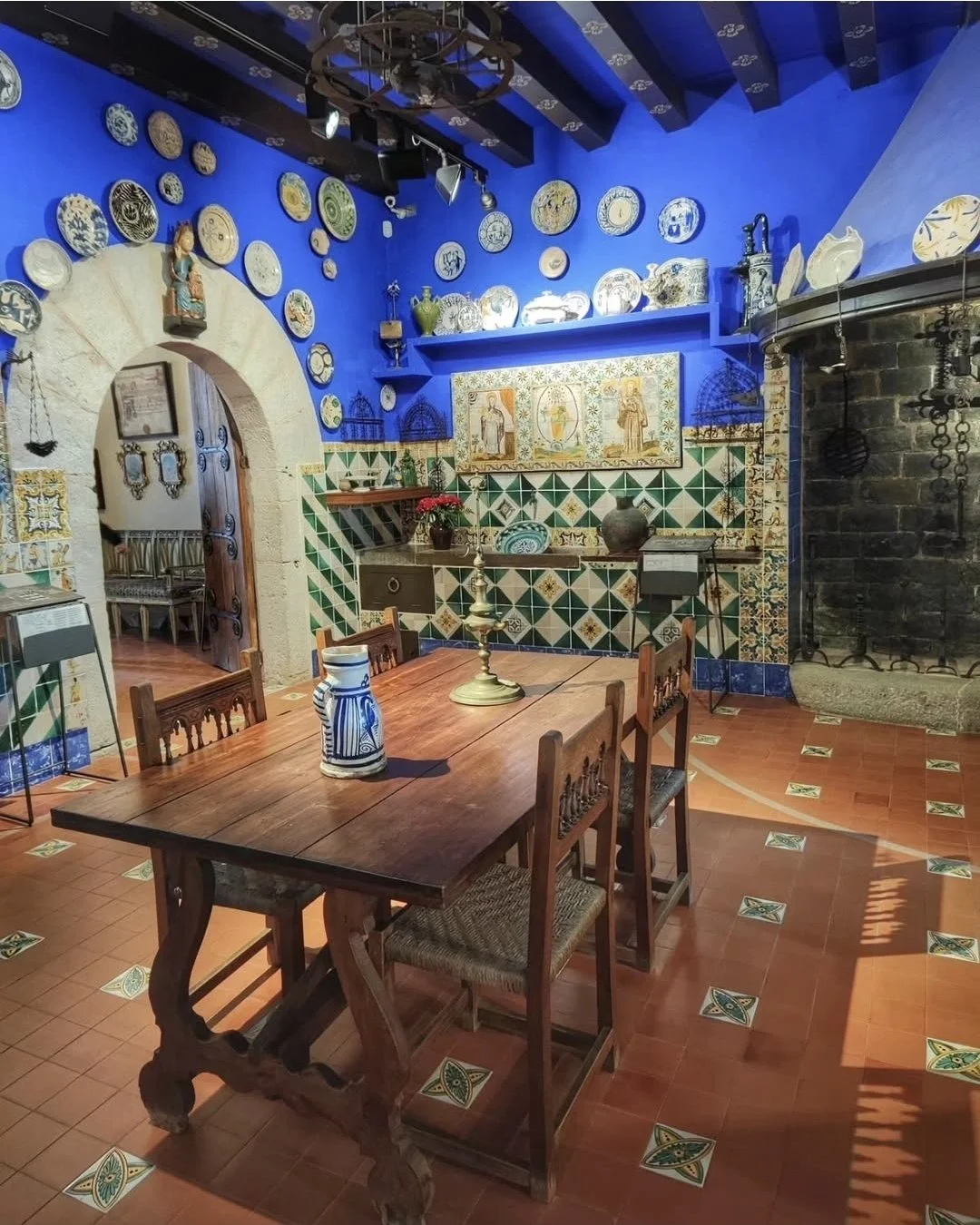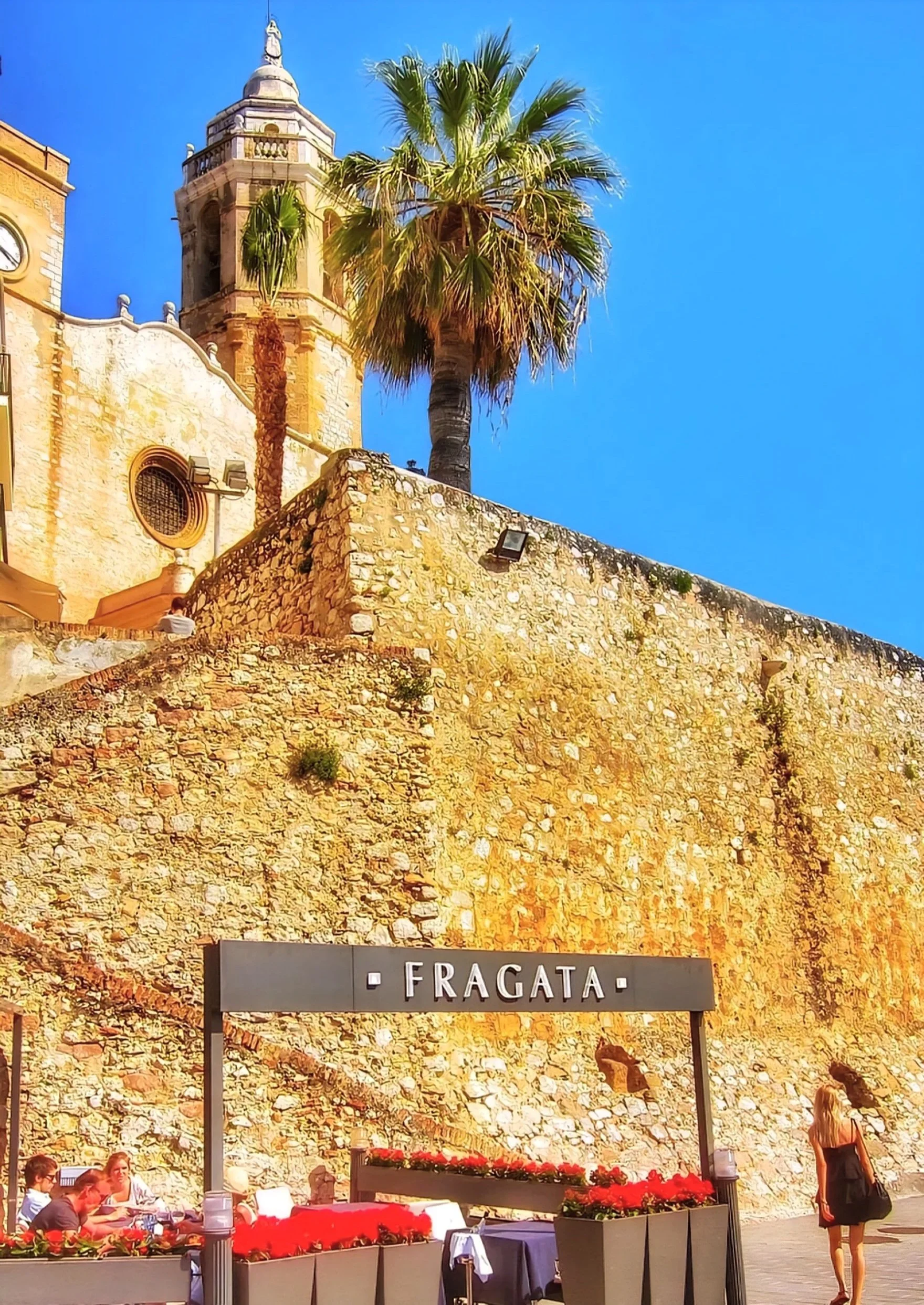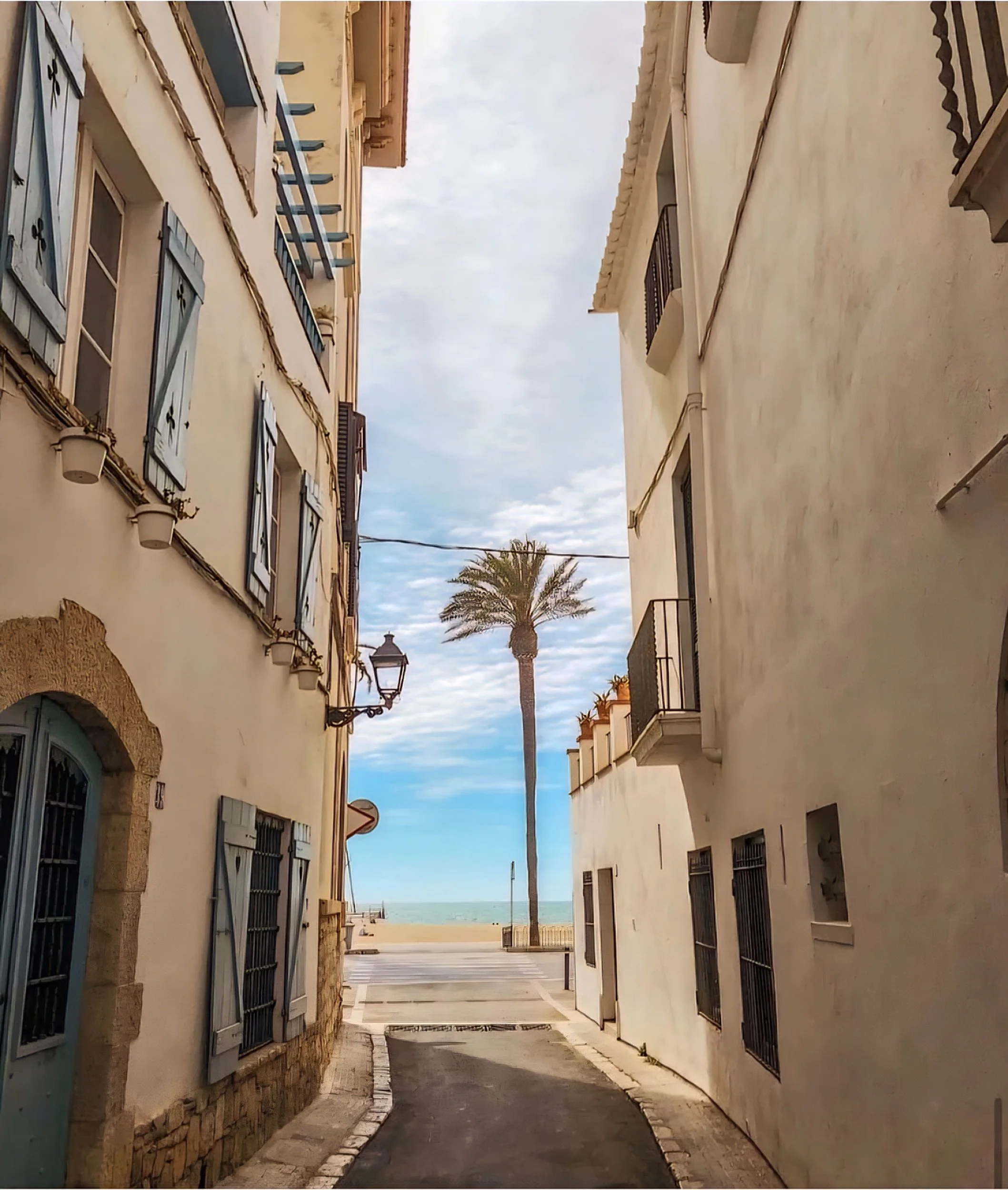Sitges: The Peaceful Seaside Escape Just 35 Minutes from Barcelona
When people hear “Sitges,” the same images often come to mind: the famous film festival that draws international crowds, the riot of colour and music during Carnival, a nightlife scene that seems to go until sunrise, and beaches packed with umbrellas in the height of summer. Sitges has built an international reputation as a lively coastal escape from Barcelona, and for many travellers, that’s exactly the appeal.
For others, it’s the reason to avoid it altogether. If your version of the perfect trip is a slow walk along cobblestone streets, stopping to photograph a doorway framed with bougainvillea, or finding a café where the owner greets you like a regular and the coffee arrives without you having to order, you might assume Sitges has nothing for you. That was my impression too.
I used to think of Sitges as all noise and movement. Then I discovered that it is really two towns in one. There’s the high-season Sitges, which is full of music, events, and the hum of beach bars. And then there’s the other Sitges, the one that belongs to early mornings, to the months between seasons, and to the quieter residential streets just beyond the main promenade.
It’s still the same whitewashed, sunlit place, but the pace is slower. The soundscape changes from clinking glasses and bass lines to the murmur of locals talking outside bakeries. The air smells of the sea long before you reach the shore. Laundry flutters on balconies above narrow lanes where the only traffic is the occasional bicycle.
This is the Sitges I want to show you. The one you can reach from Barcelona in just over half an hour and yet still feel like you’ve stepped into somewhere far removed from the city’s constant rhythm. In this guide, I’ll share exactly how to find it, where to stay so you can enjoy the calm mornings and quiet nights, where to eat without joining the tourist rush, and which corners to wander when you want the town to feel like it’s yours alone.
Getting to Sitges by train
The R2 Sud train is by far the most straightforward way to get to Sitges from Barcelona, and part of the pleasure is that it feels like a trip in itself rather than just transport. You can catch it at Sants, Passeig de Gràcia, or Estació de França. If you want to make the journey part of the experience, aim for a window seat on the right-hand side after Castelldefels. That’s when the track leaves the suburbs behind and begins to follow the coastline. The view opens suddenly to flashes of turquoise water and rocky coves, with fishermen’s boats anchored in small harbours. It’s a perfect start to a slow travel day.
Trains run frequently, but timing matters if you want to see Sitges at its calmest. Avoid arriving between 11 am and 3 pm in July and August when the heat and the day-tripper crowds peak. Instead, catch an 8:48 am or 9:18 am train. You’ll step off just as the first bakeries are putting pastries in their windows and the narrow lanes are still in shadow. The air feels cooler, scented faintly with coffee and salt from the sea.
Once you arrive, resist the instinct to follow the flow of passengers down Carrer de Jesús to the promenade. That’s the quickest way to the beach, but also the quickest way into the busiest part of town. Turn left instead, toward the old town backstreets. Within two minutes, the noise fades. Streets like Carrer de l’Aigua, Carrer de la Carreta, and Carrer Major show you a quieter Sitges, one where balconies drip with geraniums and morning light filters between whitewashed walls.
If you take this detour, you’ll pass a tiny corner bakery on Carrer de l’Aigua that sells still-warm ensaimadas. Buy one for later and carry it in a paper bag as you wander. You might also spot Librería Alex, a little second-hand bookshop that doesn’t have a sign big enough to catch the average tourist’s eye. Step inside for a moment; the owner is happy to recommend a beach read from the jumble of shelves.
By the time you emerge back toward the main part of town, you’ll already have had your first taste of Sitges without ever touching the crowded promenade.
Best Boutique Hotels in Sitges for a Quiet Stay
If you can spare more than a day, staying overnight in Sitges is worth it. The mornings and evenings are the quietest times, and you’ll avoid the midday rush of day-trippers.
Here are stays that suit travellers looking for small, character-filled places rather than large, anonymous hotels.
Casa Vilella
Boutique beachfront hotel located at the quieter end of the promenade. Rooms are spacious, with sea or garden views, and the breakfast area overlooks palm trees. Ideal if you want beach access but without the constant foot traffic outside.
Sitges Royal Rooms
Small guesthouse with only a handful of rooms, each decorated with vintage furniture and patterned floors. Central location but on a side street, so it stays quiet at night.
Hotel Medium Sitges Park
Set in a restored 19th-century building. There’s a shaded courtyard pool, and the location works well for exploring both the beach and old town on foot.
Private Apartments in the Old Town
If you want more independence, look for Airbnb or Vrbo rentals within the old town. Avoid the newer blocks near the train station as they tend to be noisier. Older streets are calmer, and you’ll be steps from cafés and bakeries.
Choosing accommodation with the right location will make your visit more relaxed. If you can walk to everything and avoid busy streets, you’ll have a much better experience of Sitges.
If you’re drawn to Sitges’ quieter side, you’ll love the peaceful feel of Uzès in spring - check out our Slow Living, Lilacs & Long Lunches guide to see why.
Morning in Sitges: Coffee, Breakfast and Exploring the Old Town
café la punta
Once you’ve dropped your bag or stepped off the train, start your day with coffee somewhere away from the beach. La Punta de Sitges is a solid choice for smooth coffee and fresh juice, with a few outdoor tables in a quiet spot. If you want something with character, Café Roy has been here for years and feels like the kind of place where the barista might ask how your week’s going.
From there, take your time wandering the old town. This is where you’ll find the oldest buildings, like the 17th-century Casa Bacardí (yes, that Bacardí — the founder was born here), and tucked-away artisan shops selling ceramics, linen clothing, or handmade soap. Keep an eye out for Librería Alex, a small second-hand bookshop that often has English titles among the Spanish and Catalan shelves.
Quiet Beaches in Sitges and Coastal Walks
Sitges has 17 beaches in total, but most visitors head straight for the main ones along the central promenade. That’s where you’ll find neat rows of umbrellas, loud beach bars, and higher prices for sunbeds. If you’re looking for space to breathe, it pays to walk a little further.
Platja de Sant Sebastià
This beach sits just beyond the eastern edge of the old town. It’s smaller than the main Platja de la Ribera and attracts more locals than tourists. The water here is often calmer, and the restaurants lining the promenade behind it have a more relaxed, neighbourhood feel. In summer, aim to arrive before 11 am for a good spot, or come in the late afternoon when the crowds thin out.
Platja de Terramar
At the far west end of the Passeig Marítim, Platja de Terramar is a solid choice for a quieter swim. It’s about a 20–25 minute walk from the old town, so fewer people make the effort to get here. The beach is wide, the sand is clean, and the open feel makes it less claustrophobic than the central stretch. Bring water and snacks, as there are fewer shops nearby.
Hidden Coves near Aiguadolç Marina
If you prefer small, sheltered spots, follow the coastal path east from Sant Sebastià toward Aiguadolç Marina. You’ll pass a few rocky coves with clear water that’s great for snorkelling. These aren’t serviced beaches — no sunbeds, no cafés — so bring water shoes for the pebbles and a towel you don’t mind getting sandy. On weekdays outside of peak season, you might have one to yourself.
Walking the Full Promenade
The Passeig Marítim runs for more than a kilometre, lined with palm trees and views of the water. Most visitors stick to the central section, but if you keep walking in either direction, the atmosphere changes. Head west for more space and quieter beaches, or east toward the marina for smaller, more tucked-away spots. It’s an easy, flat walk, so you can take your time and stop where it feels right.
By going beyond the most obvious stretches of sand, you’ll see a calmer side of Sitges that many visitors miss entirely.
Best Restaurants and Tapas Bars in Sitges for Lunch
Sitges has no shortage of restaurants, but many along the central promenade rely more on their view than their food. Prices tend to be higher, and menus can be generic. For a better experience, head a few streets inland or toward the quieter ends of town.
El Cable
This is one of Sitges’ most reliable tapas bars and has been around since the 1950s. The atmosphere is casual and friendly, with a mix of locals and visitors who have done their homework. Their anchovies are a house speciality, the patatas bravas are crisp with just the right amount of spice, and they pour a decent local white wine. It can get busy, so try going for an early lunch around 1 pm to secure a table.
Pere & Pepa
For a casual option, Pere & Pepa is a small deli that’s perfect if you want to eat outdoors. They prepare fresh empanadas, sandwiches, and salads daily. Pick up a few items and take them to the beach or to one of the benches overlooking the marina. This is especially handy if you’re visiting in good weather and don’t want to spend too much time inside.
La Zorra
A good choice if you want something more substantial than tapas. La Zorra specialises in rice dishes, including an excellent squid ink paella and seasonal variations with seafood or vegetables. The dining room has a modern feel, but the focus is firmly on the food. Lunch here is more relaxed than dinner service, particularly during the week.
If you have more than one day in Sitges, it’s worth mixing these experiences. Try a long, seated lunch one day and a picnic the next. That way you can enjoy the town’s food while also making the most of its outdoor spaces.
Art, Museums and Cultural Spots to Visit in Sitges
Sitges isn’t just about sun and sand. The town has a good mix of museums and galleries for its size, and they are all small enough to enjoy without feeling like you have to rush or commit half a day. They are perfect if the midday sun gets too strong or you just want a change of scene.
Museu Cau Ferrat
Once the home of painter and writer Santiago Rusiñol, this place feels more personal than most museums. His paintings hang alongside pieces by friends like Picasso and El Greco, plus a mix of ceramics, ironwork and glassware he collected over the years. The upstairs windows look straight out to the sea, which is worth the entry fee on its own. You can see everything in about an hour, and the audio guide is short enough not to get in the way.
Museu Maricel
Right next door, Maricel has a mix of medieval religious pieces, colourful modern paintings and sculptures scattered through bright tiled rooms. The terrace overlooking the water is one of the calmest spots in town, even in high season. If you need a breather, head upstairs where it is usually the quietest.
Galeria Out of Africa
For something more modern, this small gallery shows contemporary African art, from bold paintings to intricate sculptures. The space feels more like a friendly studio than a formal gallery, so it is easy to pop in without feeling like you have to know a lot about art. Exhibitions change regularly, so there is often something new to see.
Other Spots to Check Out:
Fundació Stämpfli: A compact modern art collection that takes less than half an hour to see.
Ermita de Sant Sebastià: A small 19th-century chapel near the beach that is usually empty and nice for a quick look inside.
If you are planning to visit more than one museum, the Sitges Heritage Pass is a good option. It gets you into Cau Ferrat, Maricel and Stämpfli for less than buying separate tickets, and it is valid for a whole month so you can spread your visits over several days.
Galeria Out of Africa
Museu Cau Ferrat
Shopping in Sitges: Local Stores and Finds Worth Bringing Home
Sitges does have its fair share of souvenir shops selling fridge magnets and “I ♥ Sitges” mugs, but there are still plenty of independent places worth your time if you want something with more character. The best spots are often tucked into the old town, so it pays to wander a little.
Around Carrer de Sant Pau and Carrer Major, you will find small stores selling hand-painted ceramics, lightweight linen clothing, woven baskets, and locally made jams and honey. These make much better keepsakes than mass-produced souvenirs and are easy to pack if you are travelling light.
If you enjoy stationery, stop by Papelería Carlin. It is a small shop with a surprisingly good selection of notebooks, sketch pads, and art supplies. You would not expect to find it in a beach town, but Sitges has these little surprises if you look past the main tourist strip.
For something edible to take home, visit the weekly market on Passeig Vilafranca if your trip falls on a Thursday. You can pick up cheeses from small Catalan producers, cured sausages, and jars of local honey. Another option is Espai Gastronomic, a gourmet deli that stocks regional wines, olive oils, and sweet treats.
If vintage is more your style, there are a couple of small second-hand shops near Carrer de les Parellades. The stock changes all the time, but you can sometimes find interesting glassware, books, or retro postcards that make unique mementos.
For more destinations full of independent vintage shops and flea markets, our Best Towns for Solo Travelers Who Love Secondhand Shopping article has suggestions to bookmark.
Afternoons, Evenings, and Sunset in Sitges
Once the afternoon heat starts to fade, the promenade feels completely different. The light softens, the crowds thin, and the sea breeze makes it comfortable to walk again. If you head west past Platja de Terramar, the noise from the central beaches fades away. There are plenty of benches along this stretch, so it is worth walking until you find one with a clear view of the horizon. It is one of the best places in Sitges to watch the colours change as the sun begins to drop.
If you feel like a sweet treat before dinner, stop at Gelateria Olivier on Passeig de la Ribera. They are known for their pistachio and hazelnut ice cream, but the seasonal fruit flavours like fig or strawberry are just as good. The servings are generous, and if you walk your cone back toward the church, you can enjoy it with one of the best views in town.
For dinner, you can visit Fragata, just below the church. It’s a good option for seafood and has tables that look out over the water. Their grilled fish and seafood rice are standouts, and in cooler months, a glass of cava on the terrace is a great way to round off the day.
If you are staying overnight, take a slow evening walk through the old town after dinner. Once the day-trippers have left, the streets become much quieter. In the off-season, you might walk several minutes without passing anyone at all. The promenade is also peaceful after dark, and walking along the sand with only the sound of the waves is a nice way to finish the evening.
For a final drink, look for small wine bars in the old town rather than the louder venues closer to the beachfront. Vivero Beach Club is a bit higher up on the eastern side near the marina, and it has a more relaxed atmosphere for a nightcap with a view of the lights along the coast.
When to Visit Sitges, Average Costs and How to Avoid Crowds
Best months for a quiet Sitges trip
If you want calm streets, open beaches, and an overall slower pace, aim for October, November, February, or early March. During these months, the weather is mild enough for long walks and café sitting, and you’ll find plenty of space on the sand. For a bit more warmth while still avoiding peak summer crowds, May and September are also good choices.
Summer in Sitges
In July and August, Sitges is at its busiest. If you are visiting in these months, plan your beach time for early mornings before 10 am or evenings after 8 pm. These are the hours when the light is softer, temperatures are more comfortable, and you can still enjoy the town without the midday rush.
Average travel costs in Sitges
Coffee: €2 to €2.50
Tapas dishes: €4 to €7 each
Main meals in mid-range restaurants: €12 to €18
Boutique hotel in low season: from €120 per night
Boutique hotel in summer: €180 to €250 per night
Self-catering apartments can be a more affordable option if you are staying several days, especially if you shop at the local markets for breakfast and snacks.
Events and dates to be aware of
Sitges hosts big events that dramatically change the atmosphere of the town. Carnival in February is one of the largest in Spain, with parades, music, and packed streets. The Sitges International Film Festival in October draws big crowds and higher prices for accommodation. Both are worth experiencing if they interest you, but if you are looking for peace and quiet, it is best to avoid these weeks.
Extra tip for avoiding crowds in Sitges
Even on busier days, you can find quieter corners by walking to the far ends of the promenade or exploring the backstreets of the old town instead of the main pedestrian routes. Early mornings and Sunday evenings are often the calmest times, even in summer.
If Sitges has you craving market mornings and unhurried shopping, you’ll find lots of joy in Provence - our Quiet Market Towns in Provence post takes you to places full of authentic local markets, minus the crowds.
Sitges FAQ: Slow Traveller’s Most Asked Questions
What is the quietest beach in Sitges?
Platja de Terramar is one of the quietest beaches in Sitges. It is about a 20-minute walk west from the old town along the promenade. The walk keeps most tourists away, and the wide stretch of sand means there is more space to spread out. For something even smaller, try the rocky coves near Aiguadolç Marina, but be prepared for pebbles instead of sand.
Is Sitges worth visiting in winter?
Yes, Sitges in winter is peaceful and still gets plenty of sunny days. From December to early March, you can enjoy almost empty beaches, quiet cafés, and comfortable walking weather. While the sea is too cold for swimming, the clear light and lack of crowds make it ideal for slow travel.
How long does it take to get to Sitges from Barcelona by train?
The R2 Sud train from Barcelona takes about 35 minutes. You can catch it from Sants, Passeig de Gràcia, or Estació de França. For the best views, sit on the right side after Castelldefels, where the track runs alongside the coast.
Where can I eat the best tapas in Sitges?
El Cable is often named as the best tapas bar in Sitges. It has been open since the 1950s and is known for its anchovies, patatas bravas, and local wines. Arrive early for lunch or dinner to avoid waiting for a table.
When is the best time to visit Sitges for fewer crowds?
For the quietest experience, visit in October, November, February, or early March. These months have fewer visitors, more space on the beaches, and better availability in hotels. If you visit in summer, go out early in the morning or after sunset for a calmer atmosphere.
What should I not miss in Sitges besides the beach?
Explore the old town’s narrow streets, visit Museu Cau Ferrat and Museu Maricel for art and history, and stop at Gelateria Olivier for pistachio ice cream. Walking the full length of the Passeig Marítim is also a must for seeing the quieter sides of town.


